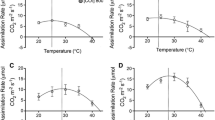Abstract
In this study we assessed the impact of elevated CO2 with unlimited water and complete nutrient on the growth and nitrogen economy of ten woody Acacia species that differ in relative growth rate (RGR). Specifically, we asked whether fast- and slow-growing species systematically differ in their response to elevated CO2. Four slow-growing species from semi-arid environments (Acacia aneura, A. colei, A. coriacea and A. tetragonophylla) and six fast-growing species from mesic environments (Acacia dealbata, A. implexa, A. mearnsii, A. melanoxylon, A. irrorata and A. saligna) were grown in glasshouses with either ambient (˜350 ppm) or elevated (˜700 ppm) atmospheric CO2. All species reached greater final plant mass with the exception of A. aneura, and RGR, averaged across all species, increased by 10% over a 12-week period when plants were exposed to elevated CO2. The stimulation of RGR was evident throughout the 12-week growth period. Elevated CO2 resulted in less foliage area per unit foliage dry mass, which was mainly the result of an increase in foliage thickness with a smaller contribution from greater dry matter content per unit fresh mass. The net assimilation rate (NAR, increase in plant mass per unit foliage area and time) of the plants grown at elevated CO2 was higher in all species (on average 30% higher than plants in ambient CO2) and was responsible for the increase in RGR. The higher NAR was associated with a substantial increase in foliar nitrogen productivity in all ten Acacia species. Plant nitrogen concentration was unaltered by growth at elevated CO2 for the slow-growing Acacia species, but declined by 10% for faster-growing species. The rate of nitrogen uptake per unit root mass was higher in seven of the species when grown under elevated CO2, and leaf area per unit root mass was reduced by elevated CO2 in seven of the species. The absolute increase in RGR due to growth under elevated CO2 was greater for fast- than for slow-growing Acacia species.
Similar content being viewed by others
Author information
Authors and Affiliations
Additional information
Received: 21 December 1998 / Accepted: 31 May 1999
Rights and permissions
About this article
Cite this article
Atkin, O., Schortemeyer, M., McFarlane, N. et al. The response of fast- and slow-growing Acacia species to elevated atmospheric CO2: an analysis of the underlying components of relative growth rate. Oecologia 120, 544–554 (1999). https://doi.org/10.1007/s004420050889
Issue Date:
DOI: https://doi.org/10.1007/s004420050889




